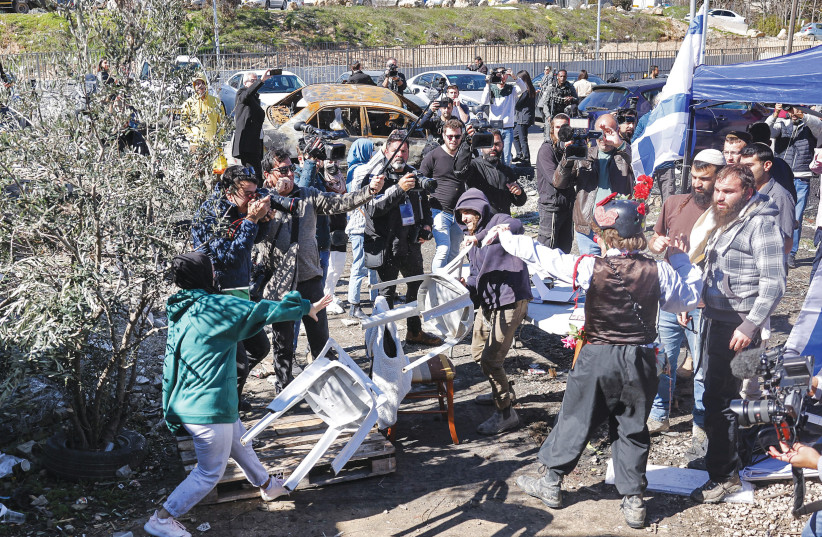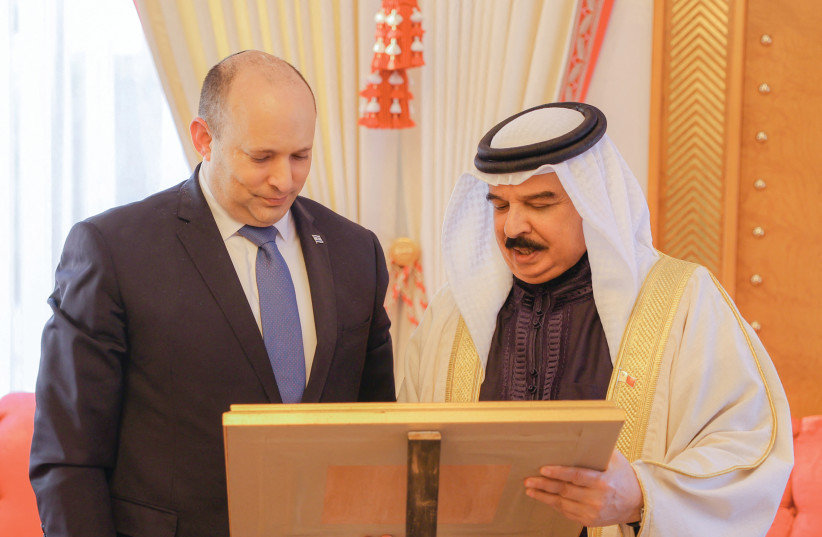 Hamas doesn’t need Sheikh Jarrah or Jerusalem to start a war – opinion
Hamas doesn’t need Sheikh Jarrah or Jerusalem to start a war – opinion
YAAKOV KATZ
This week, Ben Gvir was at the center of renewed conflicts in Sheikh Jarrah, Bennet was the first PM to visit Bahrain and Pelosi visited the Kenesset.
.

Three pictures this week told the Israeli story. The first came on Sunday, when the rabble-rouser member of Knesset and former Kach activist Itamar Ben-Gvir decided to open a temporary office in the east Jerusalem neighborhood of Sheikh Jarrah.
Ben-Gvir knew what he was doing and the attention it would gain him. Yes, a Jewish family in the neighborhood had been attacked, and the police were proving to be – yet again – ineffective; but setting up an office there was not done purely to safeguard the family. He wanted action, and that is what he got. The concern that Sheikh Jarrah could lead to another conflict with Hamas – like how the terrorist group used the neighborhood in May – means nothing to Ben-Gvir.
The second image happened on Monday, when Prime Minister Naftali Bennett flew to Bahrain and became the first Israeli leader to officially visit the tiny Persian Gulf country. Bennett was received by honor guards and with honor wherever he went, including the playing of “Hatikvah” at the palace of the Bahraini crown prince. It was Israeli diplomatic might at its best.
The third image was shown on Wednesday, when Speaker of the House Nancy Pelosi visited the Knesset. One of the most powerful politicians in the United States, Pelosi stood before the Israeli parliament and explained how the formation of the State of Israel was the greatest accomplishment of the 20th century. “The greatest”! Not insignificant words.
The three images were a piece of Israel.

In Sheikh Jarrah we saw what happens when there is a lack of police enforcement, and when the government allows pockets of lawlessness to fester. Instigators like Ben-Gvir decide to move in and violence erupts. It is the same story in the Negev, in Israeli Arab towns, and in some of the more isolated hilltops in Judea and Samaria.
The other two images portray Israel’s diplomatic prowess. There was the prime minister openly visiting a country that 18 months ago did not have formal ties with Israel, and a day later we see the speaker of the House visiting the Knesset.
It was Israeli at its best and at its worst. Israel the strong and powerful, alongside Israel the hesitant and indecisive. And that is what the Sheikh Jarrah story is about.

If all of Jerusalem belongs to Israel, then police enforcement and government control need to extend throughout all of the city, whether the violence is against Jews or against Arabs. It makes no difference.
It also is a reminder that while Bennett can go to Bahrain and Pelosi can come to the Knesset, the challenges for Israel are still momentous. One senior government official admitted this week that mistakes were previously made regarding Sheikh Jarrah, and that if the violence there continues, Israel might find itself in another round of war with Hamas in Gaza.
With that said, let us be clear about something now: if Hamas decides to attack Israel, it will have nothing to do with Sheikh Jarrah, just like it had nothing to do with Sheikh Jarrah in May. It is just an excuse. When you are a terrorist organization bent on Israel’s destruction, excuses are just that: convenient excuses. If Sheikh Jarrah did not exist, Hamas would invent it.
* * *
On Tuesday, for the first time, Israel sent a diplomatic delegation to Vienna to ensure that its concerns about the ongoing nuclear talks are heard before it is too late.
One story from 2007 – never told before – is important to keep in mind as Israel considers its options and what it might have to do, with or without a deal.
In August that year, according to foreign reports, the IDF sent a handful of elite Israeli soldiers into Syria to a region known as Deir ez-Zor.
The soldiers were specially trained to blend in with their local environment. Fluent in Arabic, they could move undetected between the various Syrian towns and cities. Their mission was simple: see if they could get close to a secret nuclear reactor that Bashar Assad was building with North Korean assistance along the Euphrates River.
Israel had been tracking the reactor with satellite imagery, but this was the first time that it had feet on the ground.
The soldiers – expert navigators – spent a good portion of their training learning how to get to places with nothing more than a compass, and sometimes even without. A lot of the preparation for this mission was spent learning the terrain in Syria so they would be able to find their target.
When presenting the mission, Military Intelligence analysts explained that while the photos obtained in an earlier Mossad raid in Europe were impressive, many of them were a few years old. To know exactly what was happening on the ground, it needed to get as close as possible to the reactor.
Before departing, the commandos had been briefed by geologists and scientists, and generals came to meet with the soldiers, who knew the risks: if something went wrong, they would be on their own. The senior officers went over the plans with the soldiers. They studied maps and ran mock simulations and models of what was ahead.
Since they were on their own, the soldiers could not carry too much with them, but this was part of the test. If Israel were to decide to send troops to blow up the reactor, the generals needed to see what each soldier could practically carry, and if enough explosives, for example, could make it there just on the backs of the operators.
The soldiers spent a week on the ground, and made it close enough to the innocent-looking structure that disguised the plutonium reactor inside.
The mission was a double success: Israel gained high-quality images of the reactor, and the IDF proved that if needed, soldiers could get inside Syria and close to the reactor.
That was of extreme importance. IDF chief of staff at the time, Gabi Ashkenazi, needed to prepare for the government a number of options for how to destroy the nuclear reactor.
The first option was the most obvious: attacking by air. The second was more complicated: sending a small elite force on the ground into Syria to plant explosives inside the reactor and destroy it from within.
Until Israel launched an airstrike on September 6, 2007, that destroyed the nuclear reactor, it had prepared two options: one from the air and the other from the ground. After the final security cabinet meeting on September 5 during which ministers voted to approve a strike, they did not yet know what course of action the IDF would choose.
That was left up to Ashkenazi.
The mission that summer proved to the IDF’s top generals that the second option was possible. With that understood, Ashkenazi now gave Sayeret Matkal permission to begin training for a large-scale covert ground operation. He knew that he could get troops near the reactor. Now he needed to decide if that was the option he was going to use.
The problem was that even within the IDF, there was a difference of opinion on the right option.
An airstrike meant that the reactor would definitely be destroyed, but it would not be something that could be hidden. People would see planes, and radar screens would detect the aerial infiltration.
A covert ground operation could be made to look like an accident, and something that could not be traced back to Israel. A small group of troops entering Syria undetected like the summer mission could potentially get in and out without anyone knowing. Sayeret Matkal trained for months for the mission up until the day of the airstrike: a small team was to infiltrate Syria, make its way to the reactor, and plant explosives inside.
Because there was very little military presence around the reactor, it was also a pretty safe gamble that the troops could get in and out without clashes.
In the end, Ashkenazi preferred an airstrike, for three reasons. First, an airstrike was almost risk-free and ensured complete destruction. While Syria did have sophisticated air defense systems, the IAF had experience flying over the country.
Second, a ground mission would be more complicated, and there would be no assurance that the commandos would be able to plant enough explosives needed to destroy the facility.
In addition, if soldiers were captured, Israel would be looking at another debacle like the one it was already facing, with Gilad Schalit being held by Hamas in Gaza and two reservists being held by Hezbollah in Lebanon. The last thing Israel needed were more soldiers captured, this time in Syria.
The story of this debate is important today as Israel considers its options ahead of a possible deal in Vienna.
The IDF has openly said that it is preparing a military option, one that would be ready in about a year.
While people tend to associate a “military option” with the Air Force, that is not Israel’s only option against Iran.
Putting commandos on the ground is something Israel did in Syria in 2007, albeit on a small scale. It is a capability that could potentially be replicated in the future to attack Iran. If that were to happen, it would mean that such a strike would be not just from the air, but also from the ground. In short – something the likes of which Israel has never seen before.
Zawartość publikowanych artykułów i materiałów nie reprezentuje poglądów ani opinii Reunion’68,
ani też webmastera Blogu Reunion’68, chyba ze jest to wyraźnie zaznaczone.
Twoje uwagi, linki, własne artykuły lub wiadomości prześlij na adres:
webmaster@reunion68.com
